Delhi, the capital of India and Sikhs have a love-hate story that goes back about 500 years. Sikh Gurus have blessed the old city with their visit. But this ancient city is also soaked with the sacred blood of many thousands of Sikh souls; the ninth Guru, and thousands of brave and fearless martyrs who died purely and simply to maintain, defend and fight for the most noble of human causes - the protection of ones liberty, the right to practice ones own religion and the freedom to live with the assurance of justice.
Nanak Piao
Gurdwara Nanak Piao is built at the site, where Guru Nanak Dev camped when he visited Delhi in 1505 during the reign of Sultan Sikandar Lodhi. Here Guru Nanak offered water to the thirsty travelers, hence the name of the shrine. The word "Piao" mean to "offer water to drink" and refers to the offering of water to all the thirsty who visited this shrine. Even today, the Well used by the Guru is preserved from which Guru Nanak served water at the shrine.
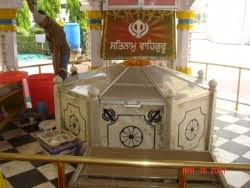
The Well at Gurdwara Nanak Piao
Majnu ka Tilla
During the historic visit to Delhi, Guru Nanak met and stayed with a local Persian Sufi mystic, Abdulla nicknamed Majnu (lost in love) on July 20, 1505. While Guru Nanak was camping atop this mound, many Sufi saints of Delhi came to meet with the Guru and held spiritual discussions. The most prominent among those who came to pay homage to the Guru was the spiritual leader of Nizamuddian Aulia shrine.
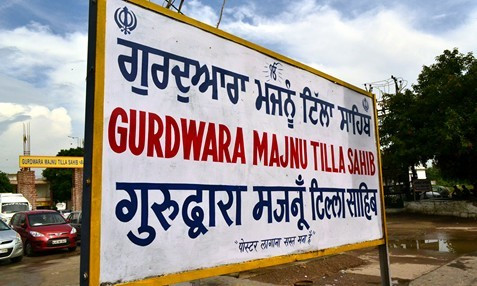
Gurdwara Majnu Tilla
Bangla Sahib
Gurdwara Bangla Sahib was originally a bungalow belonging to Raja Jai Singh of Jaipur. The area around the bungalow was known as Jaisingh Pura. This historic neighborhood was demolished to develop Connaught Place, the shopping district by the British. Raja Jai Singh requested Guru Har Krishan, the 8th Guru to bless the people of his town plagued by Small Pox Delhi in 1664. Guru Har Krishan stayed in his bungalow and helped the suffering by giving aid and fresh water from the well at this house. While serving the people, the Guru too contracted the illness and passed away on March 30, 1664. Raja Jai Singh donated the bungalow to be built a shrine in the memory of Guru Har Krishan.
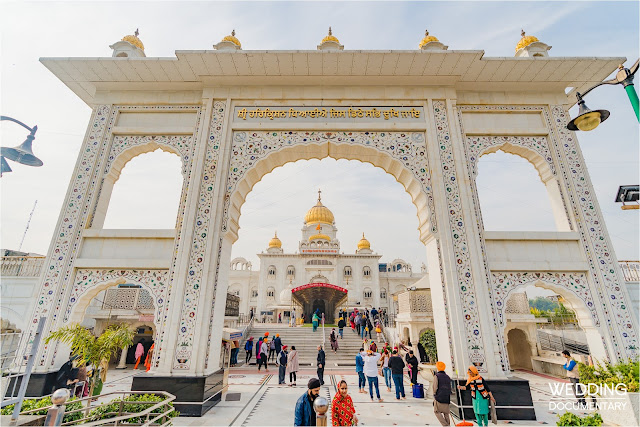
Gurdwara Bangla Sahib
Chandni Chowk
The Chandni Chowk (Moonlight Square) is one of the oldest and busiest markets in Old Delhi located near the red fort. The 9th Sikh Guru, Guru Tegh Bahadur and his followers Bhai Mati Das, Bhai Dyal Das, and Bhai Sati Das were executed at the Kotwali (Police station) by the Mughals in 1675. The Gurudwaras in the form of memorials were built in 1783 after Delhi was captured by the Khalsa (the corporate body of Sikhs) under the command of Sardar Baghel Singh.
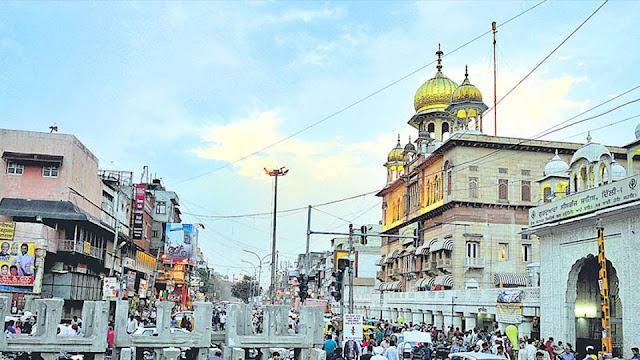
Gurdwara sisganj at Chandni Chowk
Rakab Ganj
Gurdwara Rakab Ganj marks the site of cremation of the ninth Sikh Guru, Sri Guru Tegh Bahadur ji, after his martyrdom in November 1675 for standing by the Hindu Kashmiri Pandits. Two brave Sikhs, Bhai Lakhi Shah Banjara and his son Naghaiya rescued the headless body of the Sikh Guru from Chandni Chowk, Delhi during a dust storm. On reaching their home they placed the body on a bed and set fire to their whole house for a honorable cremation of the Guru. Another devoted Sikh, Bhai Jaita carried the Guru's head to Anandpur Sahib, 500Km (300 miles) away from Sis Ganj, Chandni Chowk.
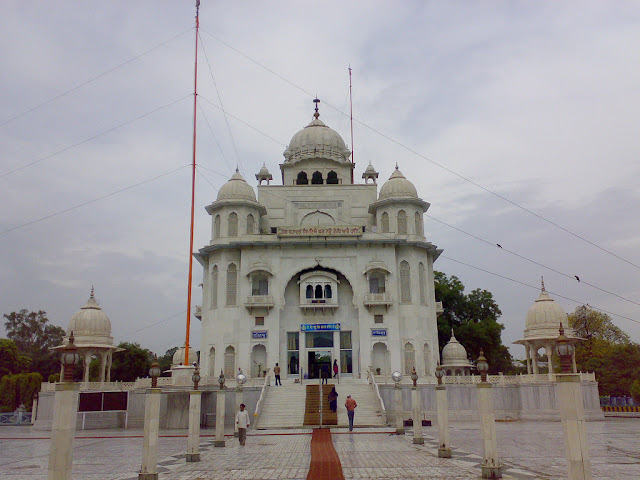
Gurdwara Rakab Ganj
Moti Bagh
Gurdwara Moti Bagh Sahib marks the place where Guru Gobind Singh camped with his army. It was the known as Mochi Bagh (Garden of Cobblers). An old story relates that the Guru, an accomplished archer, shot two arrows from a colony of cobblers in Mochi Bagh which hit the 'Divan' (throne) of Mughal Emperor Bahadur Shah. The Guru's first arrow announced his arrival in Delhi and the second arrow carried a chit saying, "It is not magic but skill of archery".
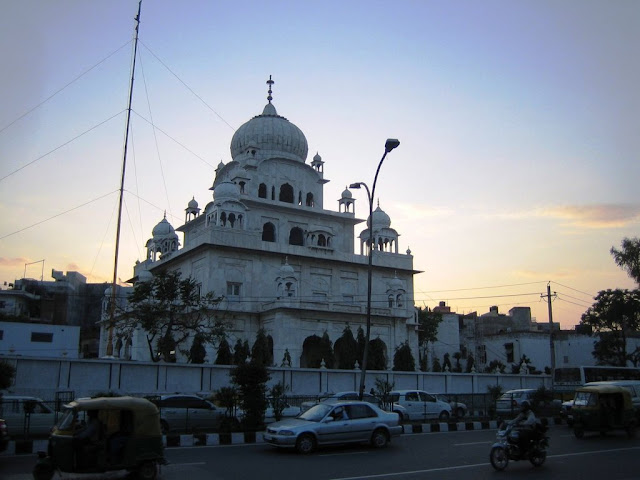
Gurdwara Moti Bagh
Mata Sundari Haveli
The Sikhs constructed an imposing shrine on the site of the Haveli, where Mata Sundri, the wife of Guru Gobind Singh stayed after the departure of the Guru to Deccan. After the passing away of the Guru in October 1708, she nurtured and guided the Khalsa for forty years. Sikhs followed her instructions and looked up to her for guidance.
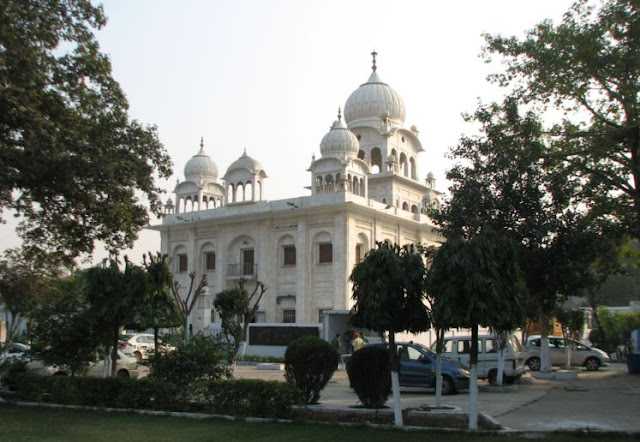
Gurdwara Mata Sundri, Delhi
Mehrauli
The streets of Delhi were witness to a macabre parade of a caged Baba Banda Singh Bahadur, his young son in his lap, followed by 780 starved and dying Sikh prisoners in chains. A march that included columns of 2,000 Mughal soldiers, each of whose spears carried the head of a fallen Sikh.
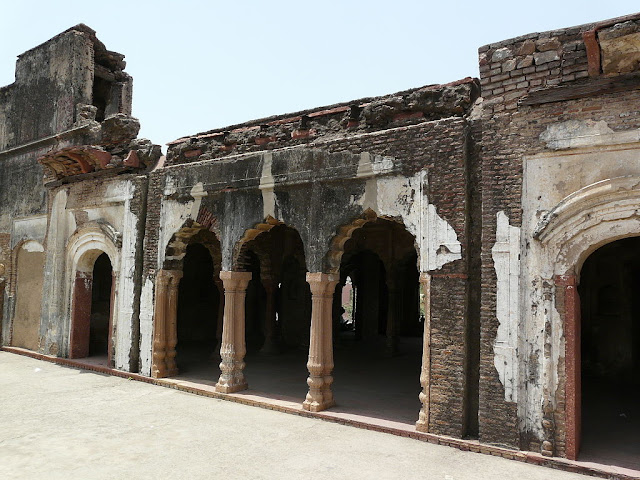
Ruins of Mughal Mehrauli
The well documented event by eye witnesses describe that wagons loaded with the heads of fallen Sikhs would bring up the rear of this gruesome display of savagery in man's recorded history. The Sikhs were brought to Mehrauli to terrorize the Indian population. They were tortured to give up their faith and become Muslims. On their firm refusal,100 Sikhs were executed seven days in public. Ajay Singh, the infant son was killed in front his father Banda Singh and his heart thrown in his lap. On 9 June 1716, Banda Singh's eyes were gouged out, his limbs were severed, his skin removed, and then he was killed.
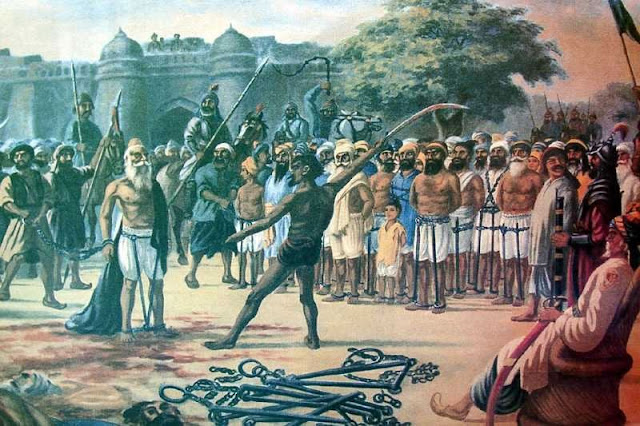
Execution of Sikhs at Mehrauli
Tees Hazari
Tis Hazari is a neighbourhood in Old Delhi houses the principal Court building in state of Delhi. The place gets its name from a force of 30,000 Sikhs, which encamped here under military general Sardar Baghel Singh in 1783, prior to attacking Delhi. The Sikh warriors overran the territory of Rohilla Nawab Najib ud-Daulah and crossed the Yamuna river from Shahdara to invade Delhi. Sardar Baghel Singh set up a Chungi post near Subzi Mandi to collect the tax on the goods imported into the city to finance the search and the construction of the Sikh Temples. He often distributed sweets to the locals at the place which is now known as the Pul Mithai.
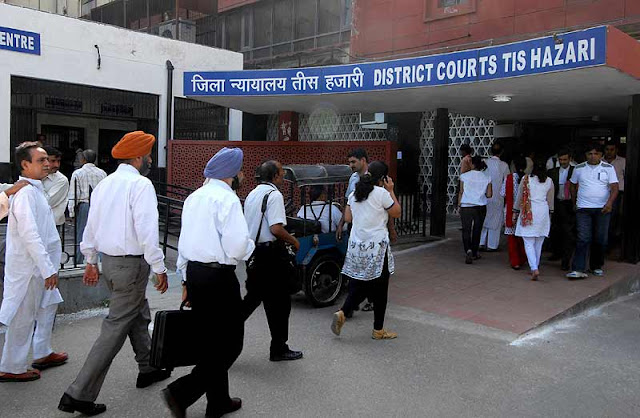
Tis Hazari Court, Delhi
On March 8 the Sikhs captured Malka Ganj and Subzi Mandi. Prince Mirza Shikoh, on orders from the Emperor, tried to stop the invaders but suffered defeat, and fled. On March 9 they captured Ajmeri Gate. There was a panic in the city; many took shelter in the fort.
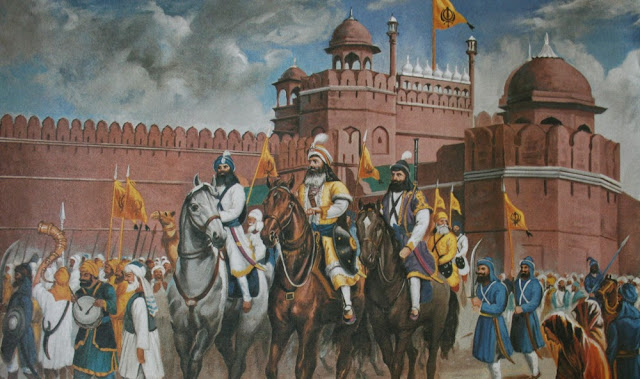
Baghel Singh leading Dal Khalsa in Delhi
Mori Gate
The Sikhs attacked the Red Fort on March 11,1783. The Emperor and all his guards, in fact every one in the fort, hid themselves. The story goes that an insider informed Sikhs of a weak spot in the wall of the fort, where the soldiers made a hole by ramming it with wooden logs; the place is named as Mori Gate, the location of Inter State Bus terminus (ISBT).
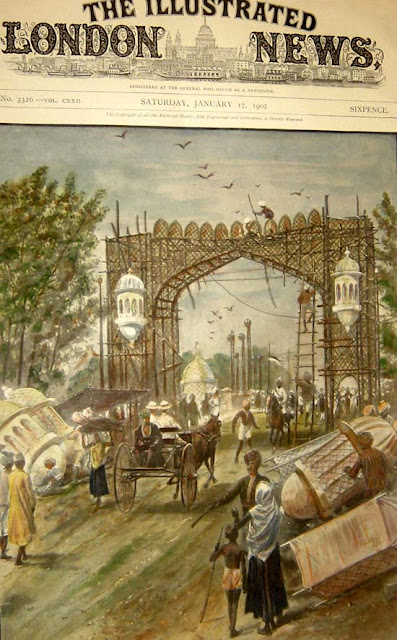
Mori Gate, delhi
The Sikhs entered the Red Fort, hoisted the kesri Nishan Sahib, and occupied Diwan-e-aam. Jassa Singh Ahluwalia’s force of Budha Dal desired to place their leader on the throne. By this time, Jassa Singh Ramgarhia arrived on the throne. He demanded immediate withdrawal of Ahluwalia from Diwan-e-Aam. Both sides drew out their swords. Ahluwalia stepped down from the throne gracefully and avoided conflict among the Sikhs.
Mughal emperor Shah Alam II made a settlement with the help of Begum Samru of Sardhana agreeing to allow Baghel Singh to raise gurdwaras on Sikh historical sites in the city and receive six annas in a rupee (37.5%) of all the octroi duties in the capital. Sikhs decided to leave Delhi with the bounty.
How Gurdwaras were Constructed
Under the Sikh-Mughal Treaty, Baghel Singh built seven Gurdwaras at the sacred places of the Sikhs. The construction of Gurdwaras was to be finished within a year at the most. Baghel Singh, as the head of 30,000 horsemen, stayed behind. They set up their camp in Sabzi Mandi-Tis Hazari area.
At the Kotwali, a huge Muslim mob gathered to protect the mosque from demolition. The situation was grave. Baghel Singh did not touch the mosque, and pulled down only a portion of the compound wall which obstructed the construction of the Gurdwara. On its completion a Brahman Sikh was appointed Granthi of the Gurdwara.
End of Mutiny by Mughal Emperor
1857 saw the uprising against the British led by Bahadur Shah Zafar, the last emperor of the Mughal dynasty. The British Army of 4,000 stationed 130 miles North, set out to retake the city held by 30,000 mutineers led by Bakht Khan, veteran army officer of East India Company. Help come from an unlikely source, the Punjab, where the British had fought a series of vicious wars with the Sikhs the most martial of the Indian warrior races. The wars ended with much mutual respect between British and Sikhs. The Sikhs volunteered to fight in such huge numbers since they looked down on the Indian Sepoys who had previously sided with the British against the Sikhs in Anglo-Sikh wars.

Hodson's Irregular Horse - The Sikhs
The storming of Delhi by the Sikhs, effectively turned the tide as the mutineers became more and more demoralized especially after their leaders were executed by Hodson’s Irregular Horse, mostly Sikhs. Hodson assisted by the Sikhs, apprehended Bahadur Shah from Humanyun's tomb. Hodson offered opportunity to the Sikhs to draw the curtain on the Mughal dynasty that had ruled over India ruthlessly.

Hodson arrests Emperor Bahadur Shah
On 22 September 1857, the Hodson's Irregular Horse captured and murdered the last three surviving young Mogul princes leading the rebellion. Their bodies hung in front of a Kotwali, just like the Mughals did to Guru Teg Bahadur. The gate near where they were killed is still called the Khooni Darwaza, or 'Bloody Gate'.
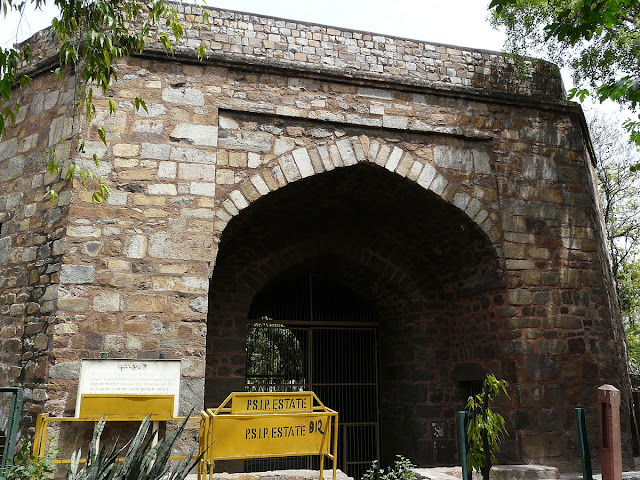
Khooni Darwaja, Delhi
Sikh Genocide of 1984
The historical Delhi witnessed the genocide of Sikhs in 1984 following the assassination of Indira Gandhi, the Prime Minister of India at the hands of her Sikh bodyguards. What followed after this, put the old city of Delhi to shame for generations. The Sikhs were targeted by violent mobs led by Congress leaders across Delhi. Gurdwaras were burned down, Sri Guru Granth Sahib desecrated, properties of Sikhs looted and set on fire. Thousands of Sikhs were butchered and their womenfols molested in their homes, streets,buses , and trains. The genocidal mobs did not even spare the historical Gurdwaras. They specifically targeted Gurdwara Rakabganj located outside the Parliament of India.
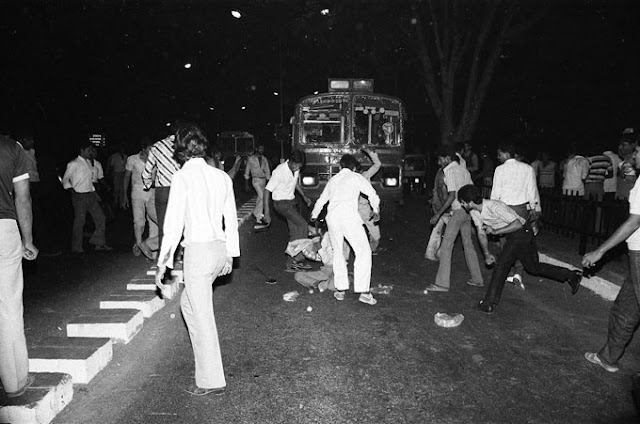
Violent Mob attacks Sikh in Delhi
Most affected were the poor Banjara Sikhs of Delhi, the descendants of Bhai Lakhi Shah who gave honorable cremation to the body of Guru Teg Bahadur. A monument marks the memory of these innocent Sikhs who were killed in sectarian pogroms, hatched and executed by the politicians of Congress party. Delhi Police turned a blind eye on the plight of the Sikhs, the natives of historic Delhi, and citizens of the country.
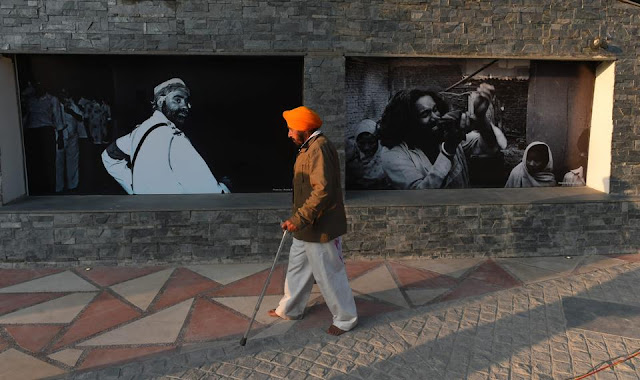
Wall of Truth - 1984 Sikh Genocide Memorial in Delhi
The history is being recorded even now as the Sikhs of Delhi mark the genocide with the "Wall of Truth". a memorial dedicated to the Sikh victims of 1984 Genocide.
References:
Nanak Piao
Gurdwara Nanak Piao is built at the site, where Guru Nanak Dev camped when he visited Delhi in 1505 during the reign of Sultan Sikandar Lodhi. Here Guru Nanak offered water to the thirsty travelers, hence the name of the shrine. The word "Piao" mean to "offer water to drink" and refers to the offering of water to all the thirsty who visited this shrine. Even today, the Well used by the Guru is preserved from which Guru Nanak served water at the shrine.

The Well at Gurdwara Nanak Piao
Majnu ka Tilla
During the historic visit to Delhi, Guru Nanak met and stayed with a local Persian Sufi mystic, Abdulla nicknamed Majnu (lost in love) on July 20, 1505. While Guru Nanak was camping atop this mound, many Sufi saints of Delhi came to meet with the Guru and held spiritual discussions. The most prominent among those who came to pay homage to the Guru was the spiritual leader of Nizamuddian Aulia shrine.

Gurdwara Majnu Tilla
Bangla Sahib
Gurdwara Bangla Sahib was originally a bungalow belonging to Raja Jai Singh of Jaipur. The area around the bungalow was known as Jaisingh Pura. This historic neighborhood was demolished to develop Connaught Place, the shopping district by the British. Raja Jai Singh requested Guru Har Krishan, the 8th Guru to bless the people of his town plagued by Small Pox Delhi in 1664. Guru Har Krishan stayed in his bungalow and helped the suffering by giving aid and fresh water from the well at this house. While serving the people, the Guru too contracted the illness and passed away on March 30, 1664. Raja Jai Singh donated the bungalow to be built a shrine in the memory of Guru Har Krishan.

Gurdwara Bangla Sahib
Chandni Chowk
The Chandni Chowk (Moonlight Square) is one of the oldest and busiest markets in Old Delhi located near the red fort. The 9th Sikh Guru, Guru Tegh Bahadur and his followers Bhai Mati Das, Bhai Dyal Das, and Bhai Sati Das were executed at the Kotwali (Police station) by the Mughals in 1675. The Gurudwaras in the form of memorials were built in 1783 after Delhi was captured by the Khalsa (the corporate body of Sikhs) under the command of Sardar Baghel Singh.

Gurdwara sisganj at Chandni Chowk
Rakab Ganj
Gurdwara Rakab Ganj marks the site of cremation of the ninth Sikh Guru, Sri Guru Tegh Bahadur ji, after his martyrdom in November 1675 for standing by the Hindu Kashmiri Pandits. Two brave Sikhs, Bhai Lakhi Shah Banjara and his son Naghaiya rescued the headless body of the Sikh Guru from Chandni Chowk, Delhi during a dust storm. On reaching their home they placed the body on a bed and set fire to their whole house for a honorable cremation of the Guru. Another devoted Sikh, Bhai Jaita carried the Guru's head to Anandpur Sahib, 500Km (300 miles) away from Sis Ganj, Chandni Chowk.

Gurdwara Rakab Ganj
Moti Bagh
Gurdwara Moti Bagh Sahib marks the place where Guru Gobind Singh camped with his army. It was the known as Mochi Bagh (Garden of Cobblers). An old story relates that the Guru, an accomplished archer, shot two arrows from a colony of cobblers in Mochi Bagh which hit the 'Divan' (throne) of Mughal Emperor Bahadur Shah. The Guru's first arrow announced his arrival in Delhi and the second arrow carried a chit saying, "It is not magic but skill of archery".

Gurdwara Moti Bagh
Mata Sundari Haveli
The Sikhs constructed an imposing shrine on the site of the Haveli, where Mata Sundri, the wife of Guru Gobind Singh stayed after the departure of the Guru to Deccan. After the passing away of the Guru in October 1708, she nurtured and guided the Khalsa for forty years. Sikhs followed her instructions and looked up to her for guidance.

Gurdwara Mata Sundri, Delhi
Mehrauli
The streets of Delhi were witness to a macabre parade of a caged Baba Banda Singh Bahadur, his young son in his lap, followed by 780 starved and dying Sikh prisoners in chains. A march that included columns of 2,000 Mughal soldiers, each of whose spears carried the head of a fallen Sikh.

Ruins of Mughal Mehrauli
The well documented event by eye witnesses describe that wagons loaded with the heads of fallen Sikhs would bring up the rear of this gruesome display of savagery in man's recorded history. The Sikhs were brought to Mehrauli to terrorize the Indian population. They were tortured to give up their faith and become Muslims. On their firm refusal,100 Sikhs were executed seven days in public. Ajay Singh, the infant son was killed in front his father Banda Singh and his heart thrown in his lap. On 9 June 1716, Banda Singh's eyes were gouged out, his limbs were severed, his skin removed, and then he was killed.

Execution of Sikhs at Mehrauli
Tees Hazari
Tis Hazari is a neighbourhood in Old Delhi houses the principal Court building in state of Delhi. The place gets its name from a force of 30,000 Sikhs, which encamped here under military general Sardar Baghel Singh in 1783, prior to attacking Delhi. The Sikh warriors overran the territory of Rohilla Nawab Najib ud-Daulah and crossed the Yamuna river from Shahdara to invade Delhi. Sardar Baghel Singh set up a Chungi post near Subzi Mandi to collect the tax on the goods imported into the city to finance the search and the construction of the Sikh Temples. He often distributed sweets to the locals at the place which is now known as the Pul Mithai.

Tis Hazari Court, Delhi
On March 8 the Sikhs captured Malka Ganj and Subzi Mandi. Prince Mirza Shikoh, on orders from the Emperor, tried to stop the invaders but suffered defeat, and fled. On March 9 they captured Ajmeri Gate. There was a panic in the city; many took shelter in the fort.

Baghel Singh leading Dal Khalsa in Delhi
Mori Gate
The Sikhs attacked the Red Fort on March 11,1783. The Emperor and all his guards, in fact every one in the fort, hid themselves. The story goes that an insider informed Sikhs of a weak spot in the wall of the fort, where the soldiers made a hole by ramming it with wooden logs; the place is named as Mori Gate, the location of Inter State Bus terminus (ISBT).

Mori Gate, delhi
The Sikhs entered the Red Fort, hoisted the kesri Nishan Sahib, and occupied Diwan-e-aam. Jassa Singh Ahluwalia’s force of Budha Dal desired to place their leader on the throne. By this time, Jassa Singh Ramgarhia arrived on the throne. He demanded immediate withdrawal of Ahluwalia from Diwan-e-Aam. Both sides drew out their swords. Ahluwalia stepped down from the throne gracefully and avoided conflict among the Sikhs.
Mughal emperor Shah Alam II made a settlement with the help of Begum Samru of Sardhana agreeing to allow Baghel Singh to raise gurdwaras on Sikh historical sites in the city and receive six annas in a rupee (37.5%) of all the octroi duties in the capital. Sikhs decided to leave Delhi with the bounty.
How Gurdwaras were Constructed
Under the Sikh-Mughal Treaty, Baghel Singh built seven Gurdwaras at the sacred places of the Sikhs. The construction of Gurdwaras was to be finished within a year at the most. Baghel Singh, as the head of 30,000 horsemen, stayed behind. They set up their camp in Sabzi Mandi-Tis Hazari area.
- The first Gurdwara was built at Teliwara in the memory of Mata Sundari and Mata Sahib Devi, wives of Guru Gobind Singh. They had lived there for some time.
- The second Gurdwara was built in Jaisinghpura where Guru Harkishan had stayed.
- Four tombs were constructed on the bank of the Yamuna at the places of cremation of Guru Harkishan, Mata Sundari, Sata Sahib Devi and Ajit Singh, the adopted son of Mata Sundari.
- There were two places connected with Guru Teg Bahadur. One was at the Kotwali where the Guru was beheaded. The other was at Rakabganj where his headless body was cremated by Lakhi Banjara.
At the Kotwali, a huge Muslim mob gathered to protect the mosque from demolition. The situation was grave. Baghel Singh did not touch the mosque, and pulled down only a portion of the compound wall which obstructed the construction of the Gurdwara. On its completion a Brahman Sikh was appointed Granthi of the Gurdwara.
End of Mutiny by Mughal Emperor
1857 saw the uprising against the British led by Bahadur Shah Zafar, the last emperor of the Mughal dynasty. The British Army of 4,000 stationed 130 miles North, set out to retake the city held by 30,000 mutineers led by Bakht Khan, veteran army officer of East India Company. Help come from an unlikely source, the Punjab, where the British had fought a series of vicious wars with the Sikhs the most martial of the Indian warrior races. The wars ended with much mutual respect between British and Sikhs. The Sikhs volunteered to fight in such huge numbers since they looked down on the Indian Sepoys who had previously sided with the British against the Sikhs in Anglo-Sikh wars.

Hodson's Irregular Horse - The Sikhs
The storming of Delhi by the Sikhs, effectively turned the tide as the mutineers became more and more demoralized especially after their leaders were executed by Hodson’s Irregular Horse, mostly Sikhs. Hodson assisted by the Sikhs, apprehended Bahadur Shah from Humanyun's tomb. Hodson offered opportunity to the Sikhs to draw the curtain on the Mughal dynasty that had ruled over India ruthlessly.

Hodson arrests Emperor Bahadur Shah
On 22 September 1857, the Hodson's Irregular Horse captured and murdered the last three surviving young Mogul princes leading the rebellion. Their bodies hung in front of a Kotwali, just like the Mughals did to Guru Teg Bahadur. The gate near where they were killed is still called the Khooni Darwaza, or 'Bloody Gate'.

Khooni Darwaja, Delhi
Sikh Genocide of 1984
The historical Delhi witnessed the genocide of Sikhs in 1984 following the assassination of Indira Gandhi, the Prime Minister of India at the hands of her Sikh bodyguards. What followed after this, put the old city of Delhi to shame for generations. The Sikhs were targeted by violent mobs led by Congress leaders across Delhi. Gurdwaras were burned down, Sri Guru Granth Sahib desecrated, properties of Sikhs looted and set on fire. Thousands of Sikhs were butchered and their womenfols molested in their homes, streets,buses , and trains. The genocidal mobs did not even spare the historical Gurdwaras. They specifically targeted Gurdwara Rakabganj located outside the Parliament of India.

Violent Mob attacks Sikh in Delhi
Most affected were the poor Banjara Sikhs of Delhi, the descendants of Bhai Lakhi Shah who gave honorable cremation to the body of Guru Teg Bahadur. A monument marks the memory of these innocent Sikhs who were killed in sectarian pogroms, hatched and executed by the politicians of Congress party. Delhi Police turned a blind eye on the plight of the Sikhs, the natives of historic Delhi, and citizens of the country.

Wall of Truth - 1984 Sikh Genocide Memorial in Delhi
The history is being recorded even now as the Sikhs of Delhi mark the genocide with the "Wall of Truth". a memorial dedicated to the Sikh victims of 1984 Genocide.
References:
- Gurdwara Nanak Piao - Wikipedia
- Majnu-ka-tilla - Wikipedia
- Gurdwara Sri Majnu Ka Tila Sahib | Discover Sikhism
- Delhi of the Sikhs | SikhNet
- Delhi - SikhiWiki, free Sikh encyclopedia.
- SikhiWiki/
- The Hero of the Siege of Delhi
- Ever thought how you are related to MORI GATE, New Delhi? – The History Behind!
- http://dailysikhupdates.com/martyrdom-baba-banda-singh-bahadur-british-texts/
- Tis Hazari - Wikipedia
- The Sunday Tribune - Spectrum
- Events - General Baghel Singh: Story Of A Crushing Mughal Defeat
- http://www.voiceofpunjab.wordpress.com
- William Stephen Raikes Hodson - Wikipedia

